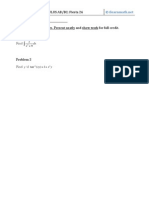Scatterplots and Correlation: Some Notes
Uploaded by
teachopensourceScatterplots and Correlation: Some Notes
Uploaded by
teachopensourceScatterplots and Correlation | SHUBLEKA
Scatterplots
• Explanatory vs Response Variable
• Form = Linear or curved relationships; clusters.
• Direction = positive vs negative association if the scatterplot has a clear direction
• Strength = how close the points lie to a simple form such as a line
• Striking deviations: outliers in either or both variables
ASSOCIATION DOES NOT IMPLY CAUSATION
Correlation:
Variables x and y for n individuals. Correlation measures the direction and strength of a relationship.
1 ⎛ xi − x ⎞ ⎛ yi − y ⎞
r= ∑ ⎜ ⎟⎜ ⎟
n − 1 ⎝ sx ⎠ ⎜⎝ s y ⎟⎠ = an average of the products of the standardized observations in x
and in y for n individuals.
Properties
9 Correlation makes no use of the distinction between explanatory and response variables
9 Requires that both variables be quantitative
9 The correlation does not change when we change the units of measurements of x, y, or both
9 The correlation r itself has no units; it is just a number
9 Positive r indicates positive association and negative r indicates negative association
9 The correlation r is always a number between -1 and 1. Values near 0 indicate weak linear
relationship. The strength of the relationship increases as r moves away from zero toward -1 or 1.
The extreme values -1 and 1 occur when the points in a scatterplot lie exactly along a straight line
9 Correlation measures the strength of only linear relationships. It does not describe curved
relationships, no matter how strong they are.
9 Like the mean and standard deviation, the correlation is not resistant to outlying observations.
Î Correlation alone is not a complete description of bivariate data. Always include the means and
standard deviations.
You might also like
- Chapter 3: Describing Relationships: Section 3.1No ratings yetChapter 3: Describing Relationships: Section 3.116 pages
- The Big Picture: Department of Statistics University of Wisconsin-MadisonNo ratings yetThe Big Picture: Department of Statistics University of Wisconsin-Madison7 pages
- Ch. 7: Scatterplots, Association, and CorrelationNo ratings yetCh. 7: Scatterplots, Association, and Correlation4 pages
- StatProb11 Q4 Mod2 CorrelationAnalysis-modifiedNo ratings yetStatProb11 Q4 Mod2 CorrelationAnalysis-modified22 pages
- Pearson Correlation Coefficient (Pearson R)No ratings yetPearson Correlation Coefficient (Pearson R)16 pages
- Module 2 - Section 4 (Linear Regression) - 11No ratings yetModule 2 - Section 4 (Linear Regression) - 1120 pages
- 4-1 Introduction To Corrrelation and Its Properties0% (1)4-1 Introduction To Corrrelation and Its Properties14 pages
- 4-1 Introduction To Corrrelation and Its PropertiesNo ratings yet4-1 Introduction To Corrrelation and Its Properties14 pages
- المادة العمية المتلقة بالارتباط والانحدار - د فواز القربي100% (1)المادة العمية المتلقة بالارتباط والانحدار - د فواز القربي150 pages
- Lecture 13 Correlation Chapter 12 Part 1No ratings yetLecture 13 Correlation Chapter 12 Part 120 pages
- Chapter 8. Correlation and Regression AnalysesNo ratings yetChapter 8. Correlation and Regression Analyses36 pages
- 628430054-Oxford-Insight-Mathematics-10-5-25-3-AC-for-NSW-Student-Book-Obook-John-Ley-Michael-Fuller-Z-lib-org_125No ratings yet628430054-Oxford-Insight-Mathematics-10-5-25-3-AC-for-NSW-Student-Book-Obook-John-Ley-Michael-Fuller-Z-lib-org_1251 page
- FX X XX X X: AP Calculus BC:: Quiz One:: Shubleka NameNo ratings yetFX X XX X X: AP Calculus BC:: Quiz One:: Shubleka Name1 page
- Fiesta 5 - 2010 - 2011 - AP CALCULUS - SolutionsNo ratings yetFiesta 5 - 2010 - 2011 - AP CALCULUS - Solutions1 page
- Class Notes: 12.2 - Sequences - H PeriodNo ratings yetClass Notes: 12.2 - Sequences - H Period5 pages
- Separation of Variables Worksheet - 2010 - 2011 - AP CALCULUS AB/BCNo ratings yetSeparation of Variables Worksheet - 2010 - 2011 - AP CALCULUS AB/BC1 page








































































